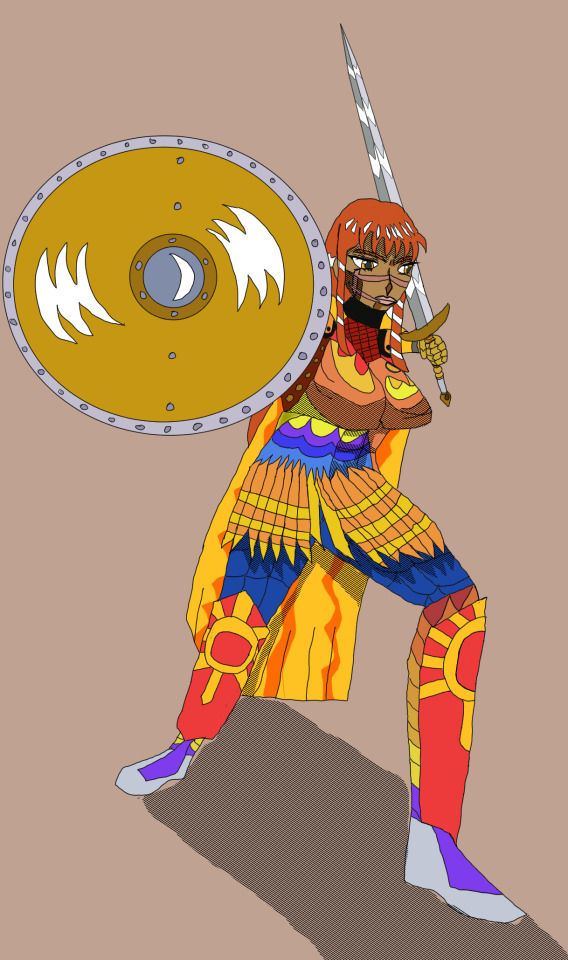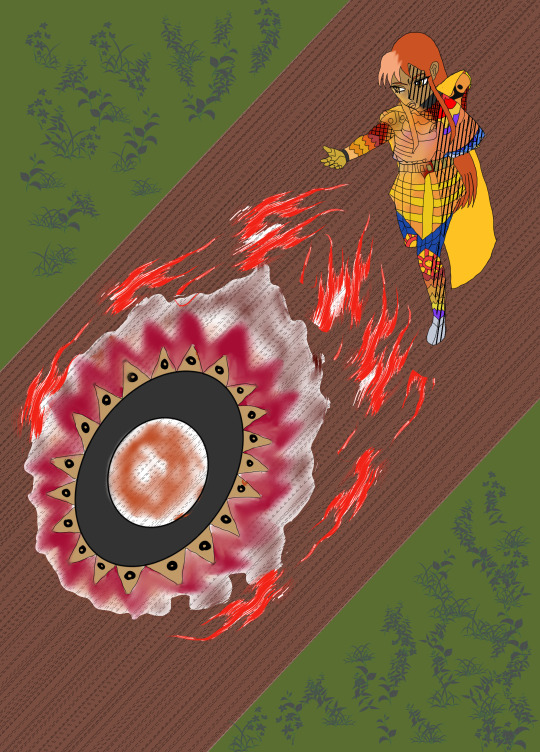#supernal studios
Text

Venom
4 notes
·
View notes
Text










A.I. generated Midnighter by supernal-studios
0 notes
Photo

Star Wars X Cyberpunk - Supernal Studios
223 notes
·
View notes
Text


Revisioned art of one of my personal OC's, Ashlynn Firemane; a Resistance Supernal Zenith Solar. Done in Clip Studio Paint Pro.
4 notes
·
View notes
Text

Darkwing Duck by Supernal Studios
3 notes
·
View notes
Text
The weapons Israel tests on Palestinians will be used against all of us
by Chris Hedges, The Real News Network
December 8, 2023
youtube
Whether it's drone technology or the infamous Pegasus spy software, Israel has long developed and refined repressive technologies used by governments around the world by testing them on Palestinians. Antony Loewenstein, journalist and author of The Palestine Laboratory: How Israel Exports the Technology of Occupation Around the World, joins The Chris Hedges Report for a deep dive into the disturbing links between Israeli Apartheid, the arms industry, and global repression of civilian populations.
Studio Production: David Hebden, Adam Cole, Cameron Granadino
Post-Production: Adam Coley, Kayla Rivara
Opening Sequence by: Cameron Granadino
Transcript
Chris Hedges: The Palestinians are human laboratory rats to the Israeli military intelligence services and arms and technology industries. Israel's drones, surveillance technology including spyware, facial recognition software, and biometric gathering infrastructure, along with smart fences, experimental bombs, and AI-controlled machine guns are all tried out on the captive population in Gaza, often with lethal results. These weapons and technologies are then certified as "battle-tested" and sold around the world.
Israel is the tenth largest arms dealer on the planet and sells its technology and weapons to an estimated 130 nations, including military dictatorships in Asia and Latin America. Israeli weapons sales totaled $12.5 billion last year. Its close relationship with these military internal security surveillance, intelligence gathering, and law enforcement agencies explains the fulsome support Israel's allies give to its genocidal campaign in Gaza.
When Colombian president, Gustavo Petro refused to condemn the October 7 attack by Palestinian resistance groups as a terrorist attack and said, "Terrorism is killing innocent children in Palestine," Israel immediately halted all sales of defense and security equipment to Columbia. This global cabal dedicated to permanent war and keeping its populations monitored and controlled has hundreds of billions of dollars a year in sales.
These technologies are cementing into place a supernational, corporate totalitarianism: A world where populations are enslaved in ways that past totalitarian regimes could only imagine. It is not a far cry from Gaza to the camps and detention centers set up for migrants fleeing to Europe from Africa and the Middle East. It is not a far cry from the carpet bombing in Gaza to the endless wars in the Middle East and the global south. It is not a far cry from the anti-terrorism laws used to criminalize dissent in Israel to the anti-terrorism laws introduced in Europe and the US. Joining me to discuss this use of Palestinians as human guinea pigs for the Israeli weapons and technology industry is Antony Loewenstein, author of The Palestine Laboratory: How Israel Exports the Technology of Occupation Around the World.
So your book, which is a great read, lays out the rise of this arms industry, which originally was a state industry and then privatized. One of the points you made at the end of the book, which is very fascinating, is how much of the apparatus to keep the Palestinians under control is essentially now handed over to private firms. I want to quote Elliott Abrams, whom I've interviewed, "The role of Israel is to serve as a model, an example in military might, in innovation, in encouraging childbirth." This is one of the themes of your book that much of Israel's support and power derives from its connection to this global arms network. So let's lay out some of the innovations that Israel has pioneered. We can begin with Pegasus and drones. They're at the forefront of some of the most advanced technologies and weapon systems that are used to control subject populations.
Antony Loewenstein: In some ways, the genesis of the book was partly due to some of the reporting around Pegasus a few years ago. Listeners or viewers will be aware that Pegasus is a spyware tool that is made by NSO Group, which is an Israeli company and it was started to be used about 15 or so years ago by a range of countries. The country that it was first mostly used in was Mexico as various governments there were desperate to fight a failed drug war, and it only made the violence worse. But what's interesting back then and also now is Mexico remains, Chris, to this day, the world's biggest and most obsessive user of Pegasus. Obsessed.
Whether it's the right-wing government or nominally left-wing government, Pegasus is now in dozens of countries. I don't even know how many, I think about 70, 80, or 90. In some ways, the reason I partly wrote the book was to say that the media was obsessed with Pegasus. Pegasus is an important investigation; It's a tool that is put on the phones of activists and human rights workers in countless countries. And it breaches human rights. That's terrible. But the problem was that it was too often framed as this rogue Israeli company doing terrible things. As I show in the book, it's not that: It's an arm of the state as Lockheed Martin and Raytheon are arms of the US government. Now, Lockheed Martin is a private company. It has a board, sure, and it makes profits or not. But essentially it's an arm of the state. Right? It's used by the government in various foreign policy agendas or goals.
Pegasus is the same. I started looking at that issue by saying that now probably, Israel is number one or two in the world for spyware, and Pegasus and NSO Group in some ways are a smokescreen. Because there are so many other companies that are doing the same thing. So if NSO Group goes bust tomorrow – And it's in a bit of financial trouble at the moment – It's not going to make any difference. There are so many other companies doing the same thing using that whole allure of being able to spy on pretty much anybody, which is why to this day no country wants to regulate this, no country. They're all obsessed with it. That's been the fundamental problem at the moment.
Chris Hedges: Explain how Pegasus works. We should note that it was also used on Jamal Khashoggi's fiance, Jamal, who I knew being a Saudi journalist who was dismembered in the Saudi embassy and a consulate in Turkey. But explain how it works.
Antony Loewenstein: Pegasus is a silent tool. It can be installed on your iPhone or Android. It doesn't matter what phone you have. Years ago, a lot of us used to get random text messages. You'd click on the link, you'd forget about it, and you'd move on. That was the way it used to work. So country X or intelligence agency Y would have this tool, let's say, in India, in some other country. They would then send a message to the phone of an activist, human rights worker, or a lawyer, that person would click on a link, their phone would be infected, and they wouldn't know.
There's no way to know yourself without it being forensically checked. These days it doesn't even require a text message. All it requires is someone knowing your number. That's it. And it can access all your information. It can even access your phone and microphone when the phone is off. So it can be used as a weapon against you. As I show in the book, I interviewed huge amounts of people in Mexico, India, and elsewhere. These are people often lawyers who are challenging the state.
In Mexico, I interviewed a woman whose husband was murdered by, almost certainly, Narcos. Then after his death, her phone was being surveilled by the Mexican state. It's never entirely clear even to this day why in her case it was surveilled. But it shows that there is this utter obsession with various intelligence services to get access to all this personal information. It's important to note that one thing that was clear in researching this particular tool is that Pegasus and tools like this have become – And it was said to be in The New York Times a few years ago, and I questioned some of this in the book but two journalists wrote – The most powerful weapon in the world since the invention of the nuclear bomb.
Now, I would question that because nuclear bombs clearly can cause carnage, to put it mildly. Pegasus doesn't directly kill anybody per se, but what it does is it means that privacy is close to dead. At the moment there is this massive proliferation of these tools. Israel of course – This is the key point – Uses Pegasus and other tools as a key foreign policy agenda. I show in the book Netanyahu and Mossad, over the last decade, would go to countries where Israel had no close relations: Rwanda and India when Modi came in, and others: Saudi, UAE. They hold Pegasus up as a diplomatic carrot saying, we will sell you this amazing tool which you can surveil your citizens, whatever you want. But in return, we would like you to vote in a certain way in the UN or buy certain weapons. That's how it works. I show a timeline when Netanyahu goes to Hungary to visit Orban or Modi in India, and 6-12 months later, Pegasus is in use. This is not accidental. This is a key part of Israeli foreign policy now.
Chris Hedges: Let's talk about the drone program. They pioneered drones. As I remember from the book, India is maybe their largest drone customer. These drones are used against migrants fleeing towards Europe, particularly Greece as well as the US-Mexico border.
Antony Loewenstein: I have some interesting declassified documents from the '80s where Israel was using drones in its war in Lebanon. When Israel invaded Lebanon in 1982, it was before the digital era, but Israel was using drones. In this amazing document that I have in the book from the CIA, they're shocked and amazed at how incredible – That's their words – These drones are, how effective they are, and they wonder – Back in the '80s – How Israel will be a global pioneer of drones. Fast forward to the last decade or so, and as I show in the book, I have spent a lot of time in Gaza as a reporter in the last 15 or so years there has been a proliferation of testing of drones, particularly around Gaza.
I'm putting aside what's happened since October 7, although it's happening since then too. But in the last 15 years huge amounts of drones are being tested above Gaza, some armed, some not, used in the various Israeli invasions, incursions, or whatever you want to call it in Gaza. Those drones are then called "battle-tested" and then they're sold to huge amounts of nations around the world. The part that shocked me the most was the use by the EU. The EU is buying Israeli drones. They're unarmed, yes. And viewers will be aware that in the last 10 or so years, there's been a huge influx of migrants coming from Africa and the Middle East, after 2015 when the Europeans said they didn't want to repeat that huge influx of people coming. Of course, if you're Ukrainian and white, they'll welcome you in. And I have no problem with Ukrainians being welcomed in. But clearly, if you're Black or Brown it's not going to be the same.
EU created this fortress, and European and Israeli drones are part of that. Frontex, which is the European border force, uses Israeli drones 24/7 in the Mediterranean, circling the Mediterranean, sending back real-time images to Frontex, which is based in Warsaw, Poland of what's happening. The EU has made a clear decision to let people drown; That is obvious. They barely issue rescue boats and they criminalize people who are trying to rescue migrants. Israeli drones are a key part of that infrastructure and eye in the sky and Israeli drones have appeared in India and various other countries. In the last years, Israel remains one of the key drone makers of the world, and increasingly, so is Turkey. Turkey makes a cheaper version of what Israel has been developing and therefore Turkish drones are now also appearing in many nations around the world in many conflicts.
Chris Hedges: Let's talk about who Israel sells to. It's easier to tick off the list of who they don't sell to. I covered the conflicts in Guatemala and El Salvador in the 1980s. Israel was supplying weapons, including napalm, to the Salvadorans and the Guatemalans. They were one of the most fervent supporters of the apartheid regime in South Africa, they worked with Pinochet's Chile, and the Rwandan genocide was perpetrated with Israeli weapons. They will provide military equipment to the most heinous regimes, including the latest ethnic cleansing in Nagorno-Karabakh. You mentioned three countries: Iran, North Korea, and I don't know who the other one was.
Antony Loewenstein: I think I say Syria.
Chris Hedges: Maybe Syria
Antony Loewenstein: As far as we're aware.
Chris Hedges: Right. As far as we're aware.
Antony Loewenstein: As far as we're aware. It's interesting to note though, that before 1979 and the Islamic Revolution, Israel and Iran were incredibly close. The fact that Iran was run by a dictator did not impede the selling of weapons. They were worried that the rise of the Islamic Revolution would impede their sales, which it did. On the one hand, I shouldn't have been that surprised. It's important to note America remains the world's biggest arms dealer. 45% of the world's arms come from America, so they are leaders by far. Israel is tenth. One of the things that shouldn't have shocked me but did was Myanmar, in the last years, has been committing genocide against its Rohingya population – Many of them have been killed and many have been kicked out into Bangladesh – Even after the UN found that Myanmar was committing genocide, Israel was still selling surveillance and weapons to the Myanmar regime.
As you say, it's hard to list. There are so many of them. It's also worth saying that India – And India is a big focus of the book because India is now the world's biggest country population-wise, the world's biggest self-described democracy. Although I would very much question that. A key ally of the US and certainly my country, Australia, and most Western nations, because it's not China – India is building a Hindu fundamental estate under Modi, a proudly chauvinist nation where Muslims are discriminated against openly. There are pogroms against Muslims. Now, India and Israel didn't have a great relationship before Modi came in. There was a relationship in decades past. Modi comes in 2014 as Prime Minister and there's a love affair between Netanyahu and Modi. There's this image that some viewers may have seen of the two of them stepping onto the beach, getting their feet wet, talking about how much they love each other, who knows, no audio was recorded.
But this relationship is central to why I wrote the book. There is a growing global ethno-nationalist surge, India being the most obvious example, of nations that proudly discriminate against non-majority populations. In India, it's against Hindus, against Muslims. In Israel, it's Jews against anyone who's not Jewish. And I say this as someone Jewish myself, that the whole alliance between Israel and India reminds me very much of Israel and South Africa: Nations that proudly discriminate against non-so-called acceptable populations and are therefore inspiring others. Israel has become the inspiration to so many countries and far-right and rightists around the world, putting aside liberal Zionists for a minute, who over the years have had a love for Israel. I'm talking about India, Hungary, and various other nations, not selling weapons but selling the idea of getting away with it.
That's something I talk about a lot in the book, that the idea that Israel can get away with it, each being occupation, endless colonization, brutalizing Palestinians, selling weapons to God knows who and God knows where, goes to the heart of why Israel is, to me, a danger. Not only to Palestinians, which is bad enough, but a model. Finally, Chris, I say in the book that you often go to far-right rallies – And I go there for work, to be clear. For work purposes – In the US, Australia, and elsewhere, the Israeli flag is a constant presence. It's not unusual and these are not groups that traditionally like Jews. They don't. I quote in the book Richard Spencer, that hideous alt-right leader in America who said a few years ago, I'm a white Zionist. He doesn't like Jewish people but he loves the idea of creating, for him and many like him, a Christian ethno-nationalist state.
You've written a lot of incredibly important work on Christian theocracy in the US and its potential growth and rise in domination. Israel is a touchpoint, as you would well know, for many of these groups. Not all, but many. And it's not because lobbyist groups like Jews; Many of them do not. But they like what Israel is doing to Palestinians to unbelievably dominate and control them. And they're proudly Jewish chauvinists. They're Jewish supremacists. That's what they want to create for Christians in America or Hindus in India. That to me is the danger.
Chris Hedges: This is from your book according to Netanyahu, Jewish writer Peter Beinarr explained, "The future belonged not to liberalism as Obama defined it – Tolerance, equal rights, and the rule of law – But to authoritarian capitalism: governments that combined aggressive and often racist nationalism with economic and technological might. The future, Netanyahu implied, would produce leaders who resembled not Obama, but him." It fits in with what you said. And unfortunately, I fear – I don't know what you think – That he's right.
Antony Loewenstein: I fear that too because it's worth saying that Obama wasn't exactly a big believer in –
Chris Hedges: No, he wasn't.
Antony Loewenstein: – Democracy and human rights either. Putting that issue aside, I fear that that is correct. And Netanyahu, I suspect, possibly hasn't got a long life left as leader of Israel. It's unclear because so many Israelis, even many who supported him, are understandably angry with him after what happened on October 7. He may not last long as a leader himself but his general analysis, I fear, is correct. Absolutely. There is this sense of country after country after country becoming enamored, not just with technological repression either from Israel or the US or others, but this idea somehow that you can maintain that domination forever.
October 7, as I touch on in the book or imply, although the book came out before October 7 is arguably a delusion. If you believe as a nation that you can repress people through technology forever, it's a lie that will not work. Gaza is a key example of that; Even though Gaza was the key laboratory of Israel, they spent billions and billions in building walls and drones and surveillance. Hamas was able to breach that relatively easily. It took years of planning to do so but I fear the lesson will not be learned.
Gideon Levy, who's a good friend of mine and an amazing Israeli journalist in Israel, has said that he fears that even now the lessons are not being learned by Israel and other leaders. What he means by that is that the lesson that Israel is taking from October 7, and the US took from 9/11, was the wrong one. It was that we need to invade and bomb and dominate even more which is born out of insecurity, not strength. Nonetheless, that's the lesson that Israel is taking, not so much that we need to talk to Palestinians or negotiate with Palestinians. Those Israelis, some are saying that, but it's a tiny minority.
Chris Hedges: In your book, you talk about Sri Lanka. You can explain what happened. They destroyed the Tamil Tigers and the Israelis were full partners in that project. That fascinated me because I wondered if that was in the playbook for Gaza.
Antony Loewenstein: A bit of background: 2009 was the end of the Sri Lankan civil war. It'd been going on for decades between the majority of the Sinhalese population and the Tamil Tigers who were a resistance movement for more Tamil rights and a Tamil homeland in Sri Lanka for years. Israel had been supporting the Sri Lankan government in selling planes, fighter jets, and other forms of technology weapons. 2009 happens and as some viewers remember, the Sri Lankan government was able to target the Tamils in a smaller, and smaller, and smaller part of the northern part of Sri Lanka.
Probably 40,000 Tamils were killed. We don't know the exact number. There's never been any real accountability for that. I do look at what's happening in Gaza and I have thought of quite a lot about Sri Lanka since October 7. I don't think there's one united plan, there is to some degree a discussion, although within very narrow bounds in the Israeli political and military establishment. Northern Gaza is obliterated. It's apocalyptic. It's probably very likely there will be a resumption of some fighting in Gaza. I don't know when, but soon. I have, as I'm sure you do, Chris, Palestinian friends in Gaza who are sheltering in refugee camps in their own country and now in the southern part of Gaza, who are struggling. Their homes have been destroyed. They have no connection to Hamas.
These are civilians living in Gaza. If Gaza's infrastructure is completely obliterated that leaves only a handful of options: Permanent tent cities in Gaza, or the dream of many of the Israeli political elite – And also let's be clear, many in the Israeli public based on public opinion polls – Kicking the Palestinians out. Egypt, Jordan, Lebanon. So far, Egypt, despite bringing dictatorship, has not acquiesced to that. They have not opened the borders enough to allow that many Palestinians into the Sinai. That could change. The Egyptian economy is on its knees. Will they accept lots of money and bribes? I very much hope not, but we don't know. I do fear the plan in Gaza is not dissimilar to what Sri Lanka did in the northern part of that country. And the outcome in Sri Lanka is that the war is over but Tamils are still regarded as second-class citizens in their own country.
Chris Hedges: Let's talk about the Alpha Gun Angels. It's a little sidelight but something disgusting that I didn't know existed until you wrote it and until I read it.
Antony Loewenstein: Yes. Well, there is a side industry, you could call it, of Israeli and Jewish women. They've often been in the military. They have fetishized or sexualized the Israeli military. You have these groups of women who are scantily clad, often holding guns, and posing in photo shoots as if they're at war in Gaza or somewhere else as an idea and a way to show two things: One, the IDF is female-friendly. You can be an incredibly sexy woman and still be in the IDF and kill Palestinians. That's the implication. Secondly, that Israeli women are cool. That's the message they're trying to send. I don't know if it's particularly effective but that's the message they're trying to send. For years I've been following this story and there's been a real push by the IDF Israeli army to show how gender-friendly they are, how gay-friendly they are, how trans-friendly they are, and how vegan-friendly they are.
We laugh in a way by saying this but I have a big section in the book talking about how this is such a key part of Israeli messaging, so-called Hasbara. I'm not entirely convinced it's massively successful. People can argue that either way but a lot of Israel's social media in the last 10 or so years has focused on this issue. We give vegan meals to soldiers who want them. We are trans-friendly, we are women-friendly, we are gay-friendly. You can wave the rainbow flag. About two weeks after the Israeli invasion of Gaza, there was this Israeli soldier in Gaza – The background was apocalyptic – Holding the rainbow flag. This image went viral. I did a story about it. The message was very clear: We want to liberate Palestinians in Gaza who are gay to be themselves.
Now, the mocking that this got, justifiably, was clear. As if people were saying, right, so you've decimated Gaza and it's apocalyptic, but gee, you can be a gay Palestinian and some may have freedom in Gaza. The cognitive dissidence to believe that. And that ties into these girls you're talking about. These women over the last few years have been traveling around Israel and the world promoting an image of Israel as liberal, but also militaristic. Pro-feminist, but also gun-friendly. That's why a lot of pro-gun groups in the US – Mostly men, let's be honest – Are into the sexualization of Israeli gun-wielding women.
Chris Hedges: We should note that one of the uses of Pegasus or the spyware was to entrap gay Palestinian men, as you write in the book, and turn them into informants.
Antony Loewenstein: Indeed. There's a big part of 8200, which is the equivalent of the US's NSA. Its whole base injector is to monitor Palestinians 24/7 across the occupied territory. So one thing they do is to try to find, so-called weak spots: A man who's married to a woman who might be gay, a man who might be having an affair with a woman. In other words, someone who is "doing something unconventional." I use that term loosely. When they get that information, they will then try to turn that person into a spy. We don't know how many Palestinians are collaborators. Some are. It's a tiny minority, but some are. In Gaza too. And it's often, as I say in the book because there's been a siege on Gaza for close to 20 years, enforced by Israel and Egypt to get out of Gaza.
I've spoken to Palestinians who have been offered this but refused it. To get out of Gaza on the Israeli side, they've been told you can leave to go to study overseas or go to a hospital in Israel or elsewhere, you have to spy for us for Israel. And that's how they blackmail people because they gather information from this 24/7 global surveillance network. Interestingly, October 7 shows that not only did the Israeli intelligence fail, was arrogance and hubris, but also the American intelligence failed. It's interesting to note since speaking to the various sources I have – And there's been some decent reporting in the last six weeks – That although the US after 9/11 is spying on Israel a lot... I talk in the book that there are about 3-400 NSA employees in the US whose everyday job is to spy on Israel. That's their job. So they're an ally, but also America doesn't entirely trust them. I'm sure that works both ways, but America was not particularly "helping" Israel to detect so-called terrorist threats.
I want to add this if I could, that I'm the co-editor and co-founder of a group called Declassified Australia, which is a news-gathering organization. We did a story a few weeks ago that showed that Pine Gap, which is a key US intelligence gathering center in my country, Australia, is used as a key intelligence-gathering venue the US used in Iraq and Afghanistan to target so-called terrorists but kill huge amounts of civilians. It's been used by the US since October 7 to give intelligence to Israel in its so-called targeting of Hamas. Now, the reason that's relevant is – Apart from the fact that you have a massive US intelligence base in the center of Australia, which is being expanded in the US expansion in my part of the world to target China. And Australia, sadly is a key ally in that madness – To have a US and Australian spy base in the center of Australia, being used to funnel information to Israel – How they're using that information is not entirely clear – It makes legal culpability very clear.
On the US side and the Australian side as it was when the US was targeting so-called terrorists in Iraq, Afghanistan, and Syria or elsewhere – I say so-called because huge amounts of civilians were killed – That global US intelligence infrastructure is being used as is the F-35A. F-35A is a weapon that Israel is using over Gaza. The global supply chain involves many countries. At Declassified Australia we also had a story showing that a key part, of when the door is being opened at the bottom of the F-35 to drop weapons on Gaza, that part is made here in Melbourne, Australia. So you have a global supply chain of companies that are directly complicit in what Israel is doing which seems like, if the ICC is listening, hello, there's a lot to be done.
Chris Hedges: Let's talk about privatization. You talk about the neoliberalism that transformed Israel, which was a socialist state, major state-owned enterprises were sold off, and privatized, especially in the 1990s. Israel has very high-income inequality: The poverty rate is 23% in Israel and 36% for the Arab population. And you write, "Many Palestinians are unaware of how the occupation has been privatized because it makes no difference if a state officer or private individual harasses or humiliates them." You go on to write, "Many checkpoints through which Palestinians are forced to travel to access their schools, workplaces, or Israel – If they are fortunate enough to get one of the few work permits handed out by the Jewish state – Use facial recognition technology and biometric details to document their every move." But these are private companies. So explain that. What's happened to how private for-profit firms are managing the occupation?
Antony Loewenstein: It's worth saying obviously that Israel was a self-described socialist country, but a socialist country for Jews. It's obvious to say that.
Chris Hedges: Well, yes. That's right.
Antony Loewenstein: As some older viewers will be aware, it's amazing to think now that so much of the global left was enamored with Israel for the first 20 years of its existence. Anyway, that was a bit of blindness that we can talk about some other time. But Netanyahu was a key factor in this, that yes, Israel had a quasi-socialist background. In the last 20 or so years, there's been a shift, not just neoliberal policies within Israel itself, but also outsourcing the occupation. And in some ways, it goes along with the massive expansion of settlements. You now have roughly three-quarters of a million Jewish settlers living in occupied territory, the West Bank, and East Jerusalem. A lot of the guards or security officers who are working on both settler checkpoints but also Israeli checkpoints are run by private companies. I lived in East Jerusalem between 2016 and 2020 and have been visiting there for close to 20 years. I've spent a lot of time looking into these issues and it's worth saying that it's been outsourced and the accountability was zero. Even if an Israeli soldier commits an abuse, let alone if a private interest does.
It's important also to say that a lot of these companies are Israeli, but many of them that are doing this are foreign and international. That's relevant because the UN had tried for years to release this list of global companies and Israeli companies that were directly complicit in the occupation, and therefore they should be boycotted. They released a list several years ago, it caused a big scandal in some circles, and about 20 or so of those companies then removed themselves from being involved in managing the occupation, so to speak. But there are still around 100 companies, Israeli and foreign, that are directly involved day-to-day in so-called managing the occupation. That to me is not only illegal and immoral, but also right for a boycott campaign, which I suspect will increase in the coming years after what we've seen the last six weeks.
Chris Hedges: Can you talk about AnyVision? It's changed its name to Oosto and then Unit 8200.
Antony Loewenstein: AnyVision, which has changed its name, is a facial recognition company, an Israeli company that was testing this at Israeli checkpoints. So what that means is that when Palestinians want to, say, move around the West Bank, if they want to potentially go from the West Bank into Israel proper, they have to have their details checked, their irises often checked now, and they were gathering all this information. We don't exactly know where that information was going. Still, it was going into Israel in a massive database that they were using to gather personal data on every single Palestinian, in the occupied territories. Those tools are then marketed globally. They have appeared in huge amounts of infrastructure from airports to other places around the world. And when those companies promote it, whether AnyVision uses the term "battle-tested" I'm not sure, but they are saying it's been tested in Palestine “successfully.”
And that does tie into Unit 8200, which is, as I said, Israel's NSA. It is the body that gathers intelligence on Israelis and Palestinians. I should say, that there is a lot of evidence that the occupation is coming home, that a lot of Israeli Jews who for years believed that this was only happening to Palestinians down the road, are increasingly being surveilled themselves. And I'm not talking about since October 7, although particularly since then. There is a move within Israel to criminalize dissent entirely, whether it's by Arabs or Jews.
But Unit 8200 has become this quite infamous funnel of people who have worked in the military for years, developing all these tools and methods to surveil Palestinians, which they then take to the private sector to develop various forms of repression which they can then sell around the world. And by maintaining those close ties, that's how it goes to my point earlier on, the NSO Group was essentially an arm of the state. Many of these companies, these surveillance companies, repressive tools, and biometric companies operating in the occupied territories or Gaza, are then used by Israel as a key selling point to make new friends, so to speak. It's a transactional friendship, a transactional relationship.
And it's why I think the Israeli armed industry is an insurance policy. It's an insurance policy because some countries oppose what Israel is doing. Not many, not enough, but even the countries that publicly do oppose what Israelis are doing, many of them are still buying Israeli repressive technology. Mexico is one example amongst many. Often I think words matter, sure. What a government or prime minister or president says, it's not irrelevant but what matters more is what you are doing, what you are buying, what you are deploying in your own country. So when you have 130, 140 nations in the world that in the last decades bought some form of Israeli defense technology, drones, missiles, spyware, whatever it may be, that's what matters. Israel believes, probably with justification, that those nations, at least for now, are unlikely to turn on Israel while they're so reliant on those tools of repression.
Chris Hedges: Let's talk about Blue Wolf or the Wolf Pack database.
Antony Loewenstein: So this is a system that has been developed in the last five or so years that every Israeli soldier operating in the occupied territories has. The aim is to get personal information and data on every single Palestinian man, woman, and child. It's entered into a massive database. That is then used to discriminate against those people potentially. What does that mean practically? Person X wants to go from the West Bank to Israel to work to get medical care. A Palestinian does not know what information has been collected on them, there's no consent.
There's testimony given usually anonymously, by Israeli soldiers, where it's almost like a game. How many Palestinian personal details can we get on our mission tonight when we're serving in the occupied territories? It goes without saying, but there is no transparency in this process. Zero. So Palestinians living in Hebron or Nablus or somewhere else, don't know what information is being gathered, but we do know that it's impacting their freedom of movement from place to place within the West Bank and also potentially further afield into Israel or overseas.
Chris Hedges: "Israel innovates all sorts of crowd control," you write. Sea of Tears, a drone that dropped tear gas canisters over a broad area, skunk water, the skunk water drone, a form of liquid emitted from a water cannon that left a foul smell on clothes and body for a long time. They were used on the Great March of Return, which was a largely nonviolent protest movement in Gaza where they went up to the border. Many of them, of course, were shot. Talk about some of the forms of crowd control that have been pioneered by Israel, that we have seen in places like Ferguson.
Antony Loewenstein: Yeah. Well, this is something I talk about in the book, Chris, that there is a sense that Israel is using the West Bank, particularly East Jerusalem and Gaza, as a testing ground. Some of those examples then explain what they are. The Great March of Return, as you said, was Palestinians trying to march for their freedom and for the right to return to Israel where their ancestors used to live. The Sea of Tears was a drone that was dropping tear gas on people. It didn't kill them but it certainly caused huge damage. And literally, while the March of Return was happening and while that drone, the Sea of Tears, was being used – I document this in the book – Other countries were wanting to buy it because it was being tested, so to speak, in real-time.
The connection between the US and Israel is key here. Soon after 9/11, there was a massive attempt by the pro-Israel lobby in the US, the Anti-Defamation League particularly, but other groups as well to have information sharing. So huge amounts of police forces went between Israel and the US and vice versa, training in tools of "people management." They're examples of police officers who have these quotes in the book going to Israel after 9/11, being inspired by what Israel is doing to Palestinians. Let's be clear, as I say in the book, American police don't need Israeli training to be repressive against Blacks and minorities. I'm not arguing that. But what I am saying is that they're getting new tools of repression to the point where quite recently you had major Israeli border security individuals on the US-Mexico border looking at how the US "maintains" its border.
And it's worth saying, you mentioned this before, I didn't fully answer that, that on the US-Mexico border, there is a key part of that infrastructure, which was started by Obama, deepened by Trump, and continued by Biden now, of Israeli surveillance. There are massive Albert surveillance towers all across the US-Mexico border. Elbit is Israel's biggest defense company. The reason the US initially was interested in this technology was because it had been tested and tried in Palestine, and "it works." So you have all these massive surveillance towers. The aim is to both surveil potential migrants crossing the border and importantly Native Americans who live on their ancestral territory. And I have quotes in the book saying they can't live securely in their territory because of these surveillance towers.
So again, it's worth saying that there is this ideological alignment between many in the US who view Israel as almost on the frontline, I hate to use the term, the Wild West of crowd control, crowd management, crushing any resistance to overwhelming force. And they take those examples back to the US and vice versa. It's like a feedback loop. It goes both ways. So as you say in Ferguson there was a lot of evidence that some, particularly, police in Ferguson had gone directly to Israel. That's not necessarily the case. But some of the training that police forces in the US had used, including in Ferguson, had partly come from Israel.
Chris Hedges: Talk about Frontex and how this Israeli technology is used to break into encrypted messaging apps, especially on refugee mobile phones.
Antony Loewenstein: Yeah. Frontex is the EU's border "security force." And there was a real trauma inside Frontex, not that I feel sorry for them, but trauma after the 2015 refugee surge, mostly from Syria and elsewhere. Let's not let that happen again. So now you have a situation where huge amounts of migrants are still trying to come from mostly Africa and the Middle East, escaping walls or conflicts or climate crisis disasters. And their phones, which are their smartphones – And are a vital way of knowing how to get there, people have maps on their phones, and personal details, and photos – Are often taken from people at EU border crossings. Information is taken from them. We don't know exactly what information is taken but presumably, I sense that contacts in European nations – In an attempt to try to break up what they would call people smuggling networks, what I would say is humanitarian paths to a better life – And Israeli technology is part of that. It's important to say that those Israeli drones are part of that infrastructure, but also the EU, which is Israel's biggest trading partner.
It's worth saying that. So when you have all these European nations in the last years expressing, now and then, concern about the occupation and concern about settlements. Just this week, one of the heads of the EU said, and I'm paraphrasing, in times of war, it's outrageous that Israel would spend huge amounts of money on building more settlements because Israel has released its latest budget and there are huge amounts of money for settlements. I responded on Twitter, and what are you going to do about it? Because history suggests nothing. They'll do nothing about it. Apart from the fact that I'm a German citizen and an Australian citizen, obviously in Germany, this issue is toxic: Germany is using its historical calamity, and disgusting actions during the Holocaust, including much of my family who were killed in the Holocaust, using that to support Israel's historical absolution to somehow say that to be madly pro-Israel is to atone for our sins during the 12 years of Nazi Germany.
That has a practical impact because Israel is not only selling lots of weapons to Germany, but the Germans are also selling huge amounts of technology to Israel. Since October 7, there's been a tenfold increase in weapons that Germany is selling to Israel, to assist in its horrific war in Gaza. This is what it means. So EU support for Israel. Gideon Levy, the journalist I mentioned before from Haaretz, went to a meeting with Netanyahu several years ago. Netanyahu looks at a map and says the whole world's basically in support of Israel. There are a few nations in Europe, he pointed to Belgium, that gives us a bit of trouble, but overall we're fine. Meaning occasionally the Belgian authorities express concern about settlements, which Israel doesn't care about, but ultimately the EU has decided that they will not challenge Israel, even though EU infrastructure, Chris, is being destroyed in the West Bank constantly. And I wonder how and when that will change because it hasn't changed yet.
Chris Hedges: I want to close your last chapter. You quoted an Israeli human rights lawyer "Because of surveillance tech, a country can avoid massacring protestors now. Today, we're able to identify and stop surveillance of the next Nelson Mandela before he even knows he's Nelson Mandela." What you describe in the book is the formation of a frightening, dystopian, Orwellian world that extends far beyond Israeli borders. But that, of course, Israel is integral to creating.
Antony Loewenstein: I certainly don't suggest that Israel is not able to commit massacres. And obviously, we've seen that since October 7. That quote was from Eitay Mack who is a great Israeli human rights lawyer. He spent a lot of time trying to uncover the Israeli arms industry. A lot of his work is in my book. I have quotes from people in Togo, for example, and various other nations across the globe that are often run by US-backed or Israeli-backed dictatorships back in the so-called bad old days, there were repressive regimes that were able to surveil people through various forms. Of course, that's existed forever. But the difference now is that we are so, frankly, overly reliant on phones and the internet that all this technology is monitored 24/7. It doesn't mean all information is always captured. The US issue after 9/11 was they were getting so much information, they couldn't process it. Israel has a similar problem as we saw on October 7, but as you say, Israel to me is becoming, and has been for years, one of the global inspirations for repressive tech. Long before 9/11 and long after 9/11.
The danger of that is clear, that it becomes a model for repression. Israel shows countries how to do it. You can also repress your people if you buy this technology, this spyware, this drone, whatever it may be. The technology is not perfect – They of course don't say that, but that's what I'm saying – But it can create a global, almost architecture of control that is close to unbeatable, and the impact of that at a time where democracy is in decline. You could argue that even self-described democracies aren't democracies anyway, but nations that claim to be democratic are increasingly moving more and more to an Israeli-style model. I'm not talking about an occupation, particularly. I'm talking about language. I was also talking about surveillance. The whole US rhetoric after 9/11, the so-called war on terror, was the Israeli playbook. It wasn't the same but it was remarkably inspired by what Israel had been doing in Lebanon in the '80s and onwards. Hugely similar.
Similar rhetoric about, so-called terrorism, they call it collateral damage but I would call it collateral murder. Something that a mutual friend Julian Assange – A fellow Australian, a great huge hero of mine, I've known Jillian since 2006, right at the beginning of Wiki Leaks – What people like him and many others have been saying for years is this is the threat, the idea of a complete architecture of global surveillance, which is close to unbeatable. Israel is a global leader in that. Alerting people to that is the first step. The next step is how to challenge that. A lot of the global response to October 7, both the attack by Hamas but also the insane, overwhelming, brutal war crimes that Israel is committing in Gaza, is bringing out a civil society action that I have not seen on this issue in my lifetime. I have Palestinian-Israeli friends, and I'm talking about mostly globally, not so much in Palestine, Israel itself, including fellow Jews and many Palestinians. And that to me is the only sliver of hope in what is a very dark time.
Chris Hedges: Great. That was Antony Loewenstein, author of The Palestine Laboratory: How Israel Exports the Technology of Occupation Around the World. I want to thank The Real News Network and its production team: Cameron Granadino, Adam Coley, David Hebden, and Kayla Rivara. You can find me at chrishedges.substack.com.

0 notes
Text
Powerhouse Animation Round-Up: All The Netflix Original Series Ranked

We’re always having conversations about Disney Animation, Pixar, Dreamworks and Illumination. But one of the most overlooked animation studios out there is Powerhouse Animation. The studio responsible for some of the greatest animated series of the last few years, all exclusively on Netflix. So it’s time to do a Powerhouse Animation round-up of their best shows available on Netflix.
Please note that this Powerhouse Animation round-up will be a spoiler-free discussion of all of their series on Netflix. So read on and then check out the shows yourself.
Skull Island Kickstarts The Powerhouse Animation Round-Up
Powerhouse Animation’s most recent release is a continuation of the MonsterVerse, with Skull Island. The show continues the story from the live-action Kong: Skull Island movie, in a new and exciting way. I loved the show, and how much it added a new spin to the existing universe of Kong and monster movies. And despite being the fifth entry on this list, it’s still a great animated series. Skull Island incorporates the traditional Powerhouse Animation style into jungle locales and exotic monsters, which is kind of a first. The show uses shadows and underwater animation in a really cool and interesting way. While most of the animation is in the classic 2D format, they use textures and layers in ways that are very unique and innovative.
Masters Of The Universe: Revelation Is Powerhouse Animation's Most Visually Stunning
From the mind of geek-king Kevin Smith comes the sequel to the original He-Man series from the 1980s. Along with a brilliant writing team that compromises writers like Marc Bernardin, Masters Of The Universe: Revelation is a direct continuation to the original He-Man show, that takes the story in a brand new direction. The show homages the original’s roots and spirit while updating the approach for a new generation. Powerhouse Animation does an incredible job of updating the look of the original series with brand-new animation and styles to the existing characters. The updated visuals complement the story in a great way. Not to mention the action is drastically different from the original with Powerhouse really going above and beyond with the aesthetic of the show.
Blood Of Zeus Is Powerhouse Animations’ Clash Of The Titans
Blood Of Zeus is another amazing Powerhouse Animation original that takes on the Greek mythology universe, excitingly and dramatically. While the story is absolutely brilliant, putting a new take on the Greek Gods, the animation style is breathtaking. The way that Powerhouse shows off Greek Gods with glowing light and larger-than-life backdrops of Mt. Olympus, is very stunning. An achievement that’s even greater when you think about how many other depictions we’ve gotten of these characters in various other media. So to find a new way to visually showcase these classic characters is very impressive.
Powerhouse’s animation complements the story of Blood Of Zeus that much more with some amazing visuals and insane action sequences. There is a mix of horror, supernatural, demons and God-like characters that give audiences a lot to behold in Blood Of Zeus. The show itself is one of the best new animated original series of the last decade. And definitely worth a watch.
Seis Manos Is An Underrated Anime From Powerhouse Animation
One of the more hidden gems in this Powerhouse Animation round-up is Seis Manos. Imagine an anime series with Latino characters who know Kung Fu, with supernatural elements blended into the story. It’s a genre mashup for the ages that doesn’t rely entirely on this gimmick. The story and characters are moving and have so much depth Their character arcs are superb and add substance to the action and visual components.
The action choreography in the style of 70’s action movies is incredible. The vibe of the series is very much that of the 70’s martial arts Bruce Lee movies while adding many horror and supernatural concepts as well. And seeing action done in animation so wonderfully is a feat in and of itself.
Powerhouse Animation Round-Up Ends With Castlevania!
Probably the series that brought the most acclaim to Powerhouse Animation, not to mention kickstarted Netflix’s anime library, is Castlevania. The 90s video game adaptation is a brutally mature anime that is one of the best works of storytelling I’ve ever seen in anime or live-action form. Castlevania sees a world where Dracula is a tragic and embittered lover seeking revenge from the world for the loss of his love. Along comes a generational vampire hunter who has to take him on, with some unexpected allies.
Castlevania remains one of the best all-time anime series, ever! Coupled with an insanely moving story that just grows and becomes more layered in each of its 4-seasons, the visuals from Powerhouse Animation are just incredible. The story will move you to tears, while the action and visual effects will make you stand up and cheer. It’s the perfect example of how action engages audiences that much more in the emotional core of a story.
All seasons of Castlevania are now on Netflix.
Which is your favourite Powerhouse Animation series? Let me know in the comments below or on Twitter at @theshahshahid
Read the full article
0 notes
Text
Hyundai is Trying to Certify its Flying Taxi for Commercial Use in the US
See on Scoop.it - Design, Comm, Sci and Tech
Supernal has given passengers a first look at what the cabin of its flying taxi may look like – and there are clearly some influences from parent company Hyundai Motor Group. The eVTOL (electric vertical take-off and landing) concept was revealed at the Farnborough International Airshow, in Hampshire, England, and it illustrates how the Advance Air Mobility (AAM) sector can take inspiration from the automotive market. Supernal says it teamed up with Hyundai’s design studios to create the cabin concept as it works to certify its eVTOL vehicle for commercial use in the United States in 2028, with the United Kingdom and European Union expected to follow shortly after.
In addition, it is collaborating with Hyundai’s external partners and more than 50 affiliates – spanning automobiles, automotive parts, construction, robotics and autonomous driving – to co-create the AAM value chain. The five-seat cabin concept strikes a fine balance between using automotive design processes and materials while meeting the safety standards of commercial aviation.
Read the full article at: www.iotworldtoday.com
0 notes
Photo









Infernum - ...Taur-Nu-Fuin...
1994
#Infernum#Taur-Nu-Fuin#black metal#Paganism#Occultism#Darkness#Anextiomarus#Karcharoth#Grzegorz Jurgielewicz#Rob Darken#Robert Fudali#Capricornus#Maciej Dąbrowski#Astral Wings Records#Sombre Records#Last Episode#Supernal Music#No Colours Records#Isengard Studio#forest#church
27 notes
·
View notes
Text
References
Carey, M. (2019, September 27). Toward An Antiracist Archeology. The Activist History Review; The Activist History Review. https://activisthistory.com/2019/09/27/toward-an-antiracist-archeology/
Feder, K. (2014). Prehistoric E.T.: The fantasy of ancient astronauts. In Frauds, myths, and mysteries: science and pseudoscience in archaeology. https://www.worldcat.org/title/frauds-myths-and-mysteries-science-and-pseudoscience-in-archaeology/oclc/825049150?referer=&ht=edition
Gilchrist, K. (2010). “Newsworthy” Victims? Feminist Media Studies. https://www.tandfonline.com/doi/full/10.1080/14680777.2010.514110?casa_token=CJ-20SeC_u0AAAAA%3AR7kiPj8-ntGGaHij6BtfxDMXlo8WbdqQLe3wKbSXi-axJqY56CsdEra158sdwy1YyfPihE6SOoQ
Gorman, E. H., & Kmec, J. A. (2007). We (Have to) Try Harder. Gender & Society, 21(6), 828–856. https://doi.org/10.1177/0891243207309900
Hall, M. A. (2004). Romancing the Stones: Archaeology in Popular Cinema. European Journal of Archaeology, 7(2), 159–176. https://doi.org/10.1177/1461957104053713
Holtorf, C. (2006). Beyond crusades: how (not) to engage with alternative archaeologies. World Archaeology. https://www.tandfonline.com/doi/full/10.1080/00438240500395813
Holtorf, C. (2007). The archaeologist in pop culture: key themes. In Archaeology Is a Brand! Routledge. https://doi.org/10.4324/9781315434094
Holtorf, C. (2008, March 27). Hero! Real archaeology and ”Indiana Jones and the Kingdom of the Crystal Skull” | Studio Michael Shanks ~ Stanford. Stanford.edu. https://web.stanford.edu/group/archaeolog/cgi-bin/archaeolog/2008/03/27/hero-real-archaeology-and-indiana-jones-and-the-kingdom-of-the-crystal-skull/
Kral, M. J. (2016). Suicide and Suicide Prevention among Inuit in Canada. The Canadian Journal of Psychiatry, 61(11), 688–695. https://doi.org/10.1177/0706743716661329
O’Gorman, M., & Pandey, M. (2015). Explaining low high school attainment in Northern Aboriginal Communities: An analysis of the Aboriginal Peoples’ Surveys. http://economics.uwinnipeg.ca/RePEc/winwop/2015-02.pdf
Overholtzer, L., & Jalbert, C. (2021, February 10). A “Leaky” Pipeline and Chilly Climate in Archaeology in Canada. ResearchGate; Society for American Archaeology. https://www.researchgate.net/publication/349200099_A_Leaky_Pipeline_and_Chilly_Climate_in_Archaeology_in_Canada
Renes, G., & Ridder, G. (1995). Are women overqualified. Labour Economics, 2(1), 3–18. https://doi.org/10.1016/0927-5371(95)80003-g
Romey, K. (2003). Pseudoscience in Cyberspace - Archaeology Magazine Archive. Archaeology.org. https://archive.archaeology.org/0305/etc/web.html
Sebastian, Lynne (2003) The awful truth about archaeology. The SAA Archaeological Record 3 (2), 35-37.
Smith, S. (2007). Unwrapping The Mummy: Hollywood Fantasies, Egyptian Realities. Box Office Archaeology, 16–33. https://www.academia.edu/2780165/Unwrapping_The_Mummy_Hollywood_Fantasies_Egyptian_Realities
Supernant, K., Hodgetts, L., & Lyons, N. (2020). Hodgetts et al 2020 CJA MeToo. Broadening #MeToo: Tracking Dynamics in Canadian Archaeology through a Survey on Experiences within the Discipline. https://www.academia.edu/43988565/Hodgetts_et_al_2020_CJA_MeToo
Wade, L. (2019). Beliefs in aliens, Atlantis are on the rise. Science, 364(6436), 110–111. https://doi.org/10.1126/science.364.6436.110
Wingfield, A. (2015, October 14). The Atlantic. The Atlantic; theatlantic. https://www.theatlantic.com/business/archive/2015/10/being-black-work/409990/
Winter, T. (2010). Tomb Raiding Angkor: A clash of cultures. Indonesia and the Malay World. https://www.tandfonline.com/doi/abs/10.1080/13639810304443
Zorpidu, S. (2004, January 30). The Public Image of the Female Archaeologist - The Case of Lara Croft. Academia.edu. https://www.academia.edu/5889941/The_Public_Image_of_the_Female_Archaeologist_The_Case_of_Lara_Croft
All illustrations done by Sydney Dawson
3 notes
·
View notes
Text
If only... - Jinx part 2!
Woah. I... Never ever thought that my fic could get so much love. I am so grateful for every comment and every like I received.
The whole fic was supposed to be a one shot, something to get out of my head for once but after reading your comments and seeing how lot of you would want a second part I just couldn't say no.
So this fic will have in total 4 parts. First one you already saw, it was mainly to cover what happened, what led Marinette to becoming Jinx. Second part will cover feelings of Marinette's parents--you're here! This chapter will be probably shorter? I can't really see the word count, so yeah. Enjoy!
Part 1
Part 3
Part 4
***
Paris was in chaos. It was only a day after Jinx live transmission ended and dark emotions blossomed all across the city. It was their Ladybug. It was their hero who got hurt, who let herself be akumanitazed. And even if they knew that Chat got the earrings, that be could pick new Ladybug everyone stiil held a despair in their heart. How heroes were supposed to win? How Paris was supposed to look at the fight between them and not suffer?
After the transmission, the story about Marinette's fall flew around the whole city. It didn't take long before wave of criticism crushed the school. If they only did a little bit better. If they only were a little more profesional. People were looking for someone guilty, someone who would take the blame. And no one wanted to be this person.
Day after transmission mayor held a meeting in the city hall. It was supposed to be a way to figure out the plan in the small gathering but it soon became a whole manifestation. People were angry. They wanted the end of the situation and they wanted for their Ladybug to come back.
*
Mayor forcefully closed the door and blocked them witch heavy chair. Screams and profanities just behind the walls of small room, the song of the hurt. Too strong.
Andre looked around the room. Somehow he managed to gather only a few people. Hopefully that would be enough. The Chat Noir, parents of Marinette, police officer, director of this God forsaken school, the teacher, his daughter, this girl, Lila? And a few friends of the akumatized girl.
"Alright, we have to think about the plan."
"We can't give her anything that she wants!"
"Miss Bustier have you seen what is happening?! This must stop! Marinette killed innocent-!"
"Oh would you shut up!"
Everyone looked at Chloé. She looked... Somehow more pissed than usually.
"Miss Bourgeois, your language-!"
"I said shut up! You're talking nonsense! It's not Dupain-Cheng, duh!"
Andre looked nervous.
"Honey what you..."
"It's not Dupain-Cheng! It's not our Ladybug! It's Akuma! And she has an Akuma because of her!"
Chloé shoot a nasty look in Lila's way. She knew. Chloé was one of the few who didn't believe in Lila's lies. When this whole mess started she didn't for a second believed that Dupain-Cheng did any of this nasty things. After all, she had bullied the blue haired girl for years and she never even smacked her! And this clumsy ass was supposed to push someone off the stairs? Not a chance.
Chat Noir stepped up.
"Okay, okay, let us leave this talk for another time! We have to get a plan!"
The hero turned to Marinette's parents.
"Ma'am, do you know where your daughter is?"
Sabine looked at the boy and gritted her teeth.
"Do I look like I know where she is?!"
Chat Noir looked at her.
She looked like she didn't sleep well for the past month. She looked like she was crying each and every day. She looked like she didn't eat a good meal, like she couldn't force herself to pick up the fork. She looked... fragile. Broken. She looked like she needed comfort and safety but not for herself.
Chat looked at the ground.
"... No" he said softly.
Dupain-Cheng's reported that Marinette was missing a week ago, just when it all started. They were brushed away because Paris was dealing with other problems like a constant reakumanitazations and destructions that weren't magically repairing themselves. And now everyone had to watch how Jinx was making everything worse.
Tom hold his broken hand and tried to look strong. For his wife. For... For his daughter.
If he only believed her then. If he only fought for her, tried to discover the truth... He knew his daughter. He knew that she couldn't do this kind of things. But... But he got this conclusion after it was too late. Now he looked seriously at the Chat Noir.
"What do you want to do."
It wasn't a question. It... Somehow sounded more grim that everything else. Chat looked like he was uncomfortable.
"She... She has to be stopped..."
"You want to hurt her again!"
Tom made a few furious steps toward the hero but was soon stopped by the officer.
"Mister Dupain-Cheng, please calm down! Your daughter is a victim of the Akuma, Chat Noir will try to save her!"
Tom clenched his only good hand. The broken bone remained him what happened day before and suddenly he lost all his strength.
"I... I can't do this."
He left. Sabine didn't go after him, she just sat on one of the couches and cried silently. It wasn't supposed to look like this. She needed her family. Her husband and her little beautiful daughter. Without them she felt so weak. She felt... Useless.
She regretted that day. When she lost her faith in Marinette. When she got herself caught in the lies of this awful girl. The day when she could support her princess a bit more... And maybe she would still have her. And maybe she would still be awake.
But not only this. If she showed her support even before, maybe a lot of things would be different. If she saw how stressed Marinette was, how she sometimes looked like she was so, so tired. Maybe... Maybe she could be a better mom. Maybe she could put her faith in her. Maybe she could... She didn't know! She just felt like she failed and couldn't make it better. She just wished she could at least try... But it was impossible, was it?
At the same time, Tom was walking away. Far, far away. He couldn't just stand there and listen how they wanted to hunt down his little girl. He couldn't listen how they blamed her for everything. Wasn't she just a child? His sweet baby girl. She was the same as every villain that showed up in Paris! She didn't know what she was doing! She... She didn't deserve everyone's hate. Tom stopped and tried to fight off the tears. His little girl. He looked up, at the broken ceiling and screamed.
"Hawkmoth! Hawkmoth, do you hear me?! Come here! Come and get me! Am I not broken enough?!"
Tom felt like he was making a deal with the devil but he didn't care anymore.
"Come and get me! I want to be strong! You gave it to me! Change me again! Hawkmoth!"
He needed this. He needed this strength. Tom felt tears on his cheeks.
"Hawkmoth! You bastard! G-give it to me! I-I.."
He fell to his knees.
"I need to protect her." he whispered. "I need to protect my little girl... Why can't I protect her..."
And he sat there, sobbing. No Akuma came to him. No one answered. He was left alone, weak.
He looked at his arm. It was broken because he was too reckless.
*
When he saw his daughter he couldn't stay in place. He and Sabine ran to the studio. They didn't care what she did, Marinette was their daughter. They had to make sure she was okay. Or as okay as she could be. When they saw her, they just cried. They tried to tell her to come back, to fight off Akuma... And she smiled. She began moving, floating towards them. One of her ribbons reached out to them... And he stepped up and grabbed it. Suddenly one of the heavy cameras fall over, in one second crushing his arm and hand.
"Huh... Such a luck, hm?"
"Marinette!"
"Marinette what? There is no Marinette."
"It's not like you! Please honey, stop this madness!"
The girl cocked her head.
"Stop it? But... If I stop I will go back to sleep. That's what you want?"
"No! No, no, no! Please Marinette!"
"Besides... It's not like me? That's funny."
She wrapped herself in ribbons, suddenly flickering even more than seconds ago.
"Last time something like that happened, you believed it was something I could do. What was that? Ah, yes. Pushing Lila, this little..." Jinx made and ugly face. "This... This girl from stairs. That's almost like I tried to kill her! Isn't it worse than what just happened? If you could believe I did it then, then why don't you believe it now? I mean... At least someone saw me doing it, right~?"
Sabine cried.
"Please... I... Miss you so much..."
"And you still want me to give this up. I won't be trapped anymore. I'm free now mom. Isn't it better?"
Jinx didn't wait for an answer. She just disappeared, leaving her parents alone. To cry and wait for someone to help...
****
People who wanted to be tagged:
@lenoreofraven @crazylittlemunchkin @prussianblue350 @nerdyandproudofitsstuff @pheonixashtree @absolutelywizard @lovebug5151 @yin-390 @redscarlet95 @literalfantrash @unabashedlyswimmingtimemachine @amychi2000 @im-here-for-the-content @yokizu @fatimaabbasrizvi @teresarosiadeviluke2112 @ravenabby @someone-idk-is-here @supern-a-vengers @clockaede @aloeveraspeaks @enby-witching
@map-soul
#miracoulousladybug#miracoulus#miraculous ladybug#akumatized marinette#marinette cheng#ml marinette#sabine dupain cheng#tom dupain#ladybug and chat noir#chat noir#chat#akumanette#ml akuma#Akuma#hawkmoth
469 notes
·
View notes
Text

I am malicious because I am miserable. Am I not shunned and hated by all mankind?
1 note
·
View note
Text
Super Icon - The Long Slow Death of an Indie Studio
Our History So Far…
I began developing games back in the late nineties; Xtreme Racing on Amiga was my first game, and ever since then I have only ever worked at my own development studios.
Starting with Graphic State; initially a sub-contract artwork studio, later moving into handheld game development on the Gameboy systems. This then evolved into Icon Games; focusing on small-ish console games on PlayStation and Wii.
You can view a full list of all the ‘Icon Games’ releases here:
· IconGames_Catalogue
And ‘Graphic State’ releases here:
· GraphicState_Catalogue
I founded Super Icon in 2012; an ‘evolution’ of Icon Games; like the transition from NES to SuperNES! At Super Icon the focus was on creating the games that we wanted to make, rather than trying to ride the coattails of current popular games or casual games. The focus was always trying to make great games, as good as we possibly could – games that people enjoy playing.
Our first proper release was Life of Pixel on PlayStation Mobile. We released a second PSM title around that time too, called MegaBlast.
Back in 2016, after the release of Life of Pixel on Steam and our Battlezone type shooter Vektor Wars, we decided that it would probably be best to partner with a publisher going forward. Our sales numbers were low, and we failed quite badly at building any sort of interest in the games. They didn’t completely tank, but the numbers were poor, and not enough to sustain a business.
At the time we lived in London, and during that period (we were there for about 4-years), we had tough times. I say this as possibly the world’s greatest understatement!
I attempted to document that period a couple of times in the past couple of years, and in the interest of completion I have finally released an account of our time there, which you can read here:
· RHW_MentalHealth
In addition to the financial difficulties, it covers mental health issues and was very difficult to write.
Following the above period, we moved to Cornwall – which is where we are today. Just after the move we ran a Kickstarter for another game; Best Buds vs Bad Guys. It was successful, and we managed to get funds to help complete the development. During the Kickstarter I started chatting to a great bunch of guys at a studio called Whitemoon Dreams.
The upshot was I explained we were not having much success at selling/promoting our games, and they agreed to act as a publisher on Life of Pixel and Best Buds going forward, to take them over onto PlayStation and Switch.
We worked together with them, releasing Super Life of Pixel onto PlayStation 4 and Vita in December 2018. Also, during the development phase, we pitched another title we were making, called Platform Maker. After a fair few rejections, we finally found a publisher in pQube. We renamed the game to PLATAGO, and it was released onto Steam Early Access in 2018, with a full Steam and Switch release in June 2019.
Current Development Phase – 2017 to 2019
Unfortunately, despite most players seeming to enjoy Super Life of Pixel, the sales have been poor. So bad, in fact, that Whitemoon decided they were unable to continue publishing for the time-being. As such, in the first quarter of 2019, we saw our income pretty much completely grind to a halt.
I haven’t been given any PLATAGO figures, but I suspect they are poor – it probably didn’t help that we released a couple of weeks before Super Mario Maker 2 on Switch!
We also developed Vektor Wars for Switch and PS4. Switch is out, but sales were low – since July just under 300 units. PS4 is complete and in Sony QA.
Again, my family and I faced a spell of homelessness this summer, our landlord decided to sell – and we were given 8-weeks to move out. We came closer than ever to not having a home this time, as it coincided with us also earning no revenue at Super Icon. We got lucky in the end and found a small place that we have for one year (the owners are selling early 2020), but it was scary. Added to that we have no savings or fall-back money; it was a tough time. I’m 46 this year, with three great kids who are now that much older, and it is tough for them. I think being a penniless indie develop is a younger person’s game!
Speculative development
I did have a plan though, and it seemed a good one…
In addition to the games we released above, I developed a game called They Came from Beyond (TCFB), which off and on took about 18-months (it is pre-Alpha currently). I pitched to a few publishers, and while there was interest, I didn’t manage to secure a deal. I worked on this while Steve handled code on our other projects.
Hand-on-heart, I thought it was a strong concept, and the best game we have created so far. I was certain I would secure a publishing deal to fund the completion and release, and perhaps finally have a popular game out there. The plan seemed solid – ongoing releases generating income, with a new deal secured in the later stages for our biggest project so far.
I still f#&king love TCFB too, I really do. I KNOW there are bits I need to revisit, and it needs plenty more love and content before it is ready to release, but it appears my faith was entirely misplaced.
You can read an overview document of TCFB here:
· TheyCamefromBeyond_Overview
I pitched TCFB to a lot of publishers, several of whom replied that they really liked the game and the concept, but it wasn’t a good fit for them. I would say the most common comment was that many of the publishers told me that they are shifting away from smaller indie releases like TCFB to larger scale, bigger budget projects – those with budgets up to about half a million dollars. More ‘AA’ than indie really.
So, the lower than expected sales, in combination with failing to secure a deal on TCFB has really proved to be a terminal blow.
I have also developed another title over the last 6-months, called Gates of Hell; which is a sort of follow-up FPS to Vektor Wars. Arcade action, short bursts of high score chasing.
You can read a brief overview here:
· GatesofHell_Summary
Even now, I am still developing; working on a new 2D game. A NES plus visual style shooter; with several game types in there – top down, zoomed out top down, platform run and gun. I had planned to call it ‘The Lost Carts’, but everyone I asked says that name is a bit shit!
The concept is as follows:
Some experimental NES carts have been found, which were created using a custom ‘SuperPowerFX’ chip – which allowed a 1000% increase in enemies, effects, bullets and mayhem. Unfortunately, because of the sheer numbers of enemies and arcade action these games put out, the chips used to overheat, and production had to be cancelled. Only now have the carts been unearthed, and machines are now just powerful enough to handle the gameplay without melting! I had a small series of a few games in mind.
And… one failed concept
Not long after we moved to Cornwall, I also spent about a year (off and on) on another speculative game, called ‘The Tower’.
I pitched to various publishers, and it was a no. I stopped work on The Tower, as without funding it was just too ambitious. There is a blog for it (updated until I stopped working on the project):
https://thetower-game.tumblr.com/
And you can read the pitch doc here:
· TheTower_PitchDoc
Studio Limitations
One of our key strengths as a studio is a proven track record of creating and completing games, often with very minimal budgets. In an ideal world, we would love to expand our resources so we could fully realise the vision we have for our games.
Personally speaking, I love creating games. I love the whole process; from the initial research and prototyping phase, through to making the various ideas a reality, adding little touches and cool ideas, putting it all together and trying to make it all as good as I can.
Continual restriction on resources limits what we can achieve. The result is that we make good games, but not quite great games, and unless you are very lucky, a game needs to be great to really stand out.
It also means that certain elements take longer than I would like, such as graphics and level design. These are typically the bulk of project time, and I create most of them myself, which has several drawbacks:
Quality – I am good at some things, less good at others, and I know I can find others out there who can produce far better-quality graphics than I can alone. When I do commission art, I usually have to request the minimum amount of animation and number of enemy designs. Reviewers and game players notice this instinctively they notice the quality dips, the sometimes overly generic art and lack of animation.
Limiting Factors – often our games are good fun to play, but lack that something to make them stand-out. Throughout development, there are so many ideas for cool visual & gameplay elements – bosses, new enemies, set-piece background art, cut-scenes and story artwork – that we don’t do because we can’t afford to commission artwork.
Level Design – I also handle the level design for every game we do; 2D and 3D. This way of working is probably the single most limiting factor, as you are getting ideas from just one person, and when you play the game, it shows. Most games are the product of a combination of ideas, usually from a range of different people with different tastes and experiences. Without that combination of thoughts and suggestions, a game can lack that special something to make it stand out.
Why did we not try and expand?
Both Steve and I have gone without income at times, to fund development, and when we do take income it is minimal to allow us to fund development as far as we can.
I didn’t believe we had a strong enough track record to secure financing to expand, so I didn’t pursue that option. As a studio we have developed and released more games than most; they haven’t really been successful enough financially. Also, I am on the Autistic spectrum, and this does play quite a pivotal role; I have amazing drive and focus, determination and resilience but saying I lack people skills is an understatement! I mention this because it has been the cause of without doubt the studio’s single biggest downfall; promotion.
I seem to have a complete inability to successfully promote our games, to create compelling game presentations/store pages/social media posts. I have tried many times, and never seem to get anywhere with it. Additionally, when I pitch proposals to third parties, I don’t do justice to the game and vision. As a person, I am very honest, down-to-earth, quiet and reserved – almost the opposite of someone who achieves great things through self-promotion and building a strong network of contacts.
In the past, I have sought advice from several people in the industry, showed them our proposals, asked for feedback – I have tried to improve this aspect. Most recently, when I pitched, They Came from Beyond, I managed to confuse many of the publishers who had no idea what the game was about from the proposal! I revised and adapted based on their feedback, but usually, you only get that initial chance to show the game, publishers don’t tend to revisit once they have said no.
That said, I have pitched quite a few games over the years, and secured several publishing deals – but usually for smaller amounts that are just about enough to get a game completed.
The End of an Era
From day-one, Super Icon has been a rough ride.
As covered above, our biggest issue was always been getting our games noticed and finding an audience. The actual development process is always smooth, and our game reviews are usually reasonably good. In general, everything works quite well, especially given the lack of resources we’ve always battled with.
However, we are not making money, and it has now got to the point where we need to make an urgent decision about our future.
I considered quietly closing the studio down, but I thought I’d see if there was any possibility I could sell or perhaps find a partner/investor. We don’t have much debt, a few hundred, and everything is in good order. We have accounts for each year since incorporation, prepared by our accountants EXCEED based in Surrey.
I spent the last few days reaching out to some contacts of LinkedIn; some amazing, talented and successful people – kind of a last attempt to salvage the studio as it is.
I put together a couple of docs which covered the various aspects of Super Icon, the way the studio has worked, the whole development process. You can read them here:
a. Studio profile doc:
LINK
b. Overview of our development process:
LINK
This morning though, I have reached the conclusion that we are done. The feedback has been that our games/studio is essentially pretty much worthless. I expected this, but there is always a small glimmer of hope – perhaps that has always been my biggest failing?
Years of fighting tooth and nail just to survive, just to live. Messing up my family’s stability and security, mentally breaking down, and so often treated like shit by landlords, accountants, etc.
I have tried so very hard to make it work, and I always had that hope I could one day do it. Unfortunately, I am now middle-aged with zero pension, no savings or home and a very uncertain future. Time has a way of creeping up on you, one day you think – I still have a long time to turn things around - then suddenly you think, shit, I’m nearly fifty now; an Autistic games industry fuck up with terrible people skills, crippling self-hate and an on-going mental health battle.
I have made A LOT of games that aren’t worth shit, I have an impressive inability to self-promote and perhaps I am now rather out of touch with the industry as a whole?
The main practicality though is that we just can’t afford to continue. Super Icon can’t afford to get the accounts done or pay the monthly studio bills. I don’t really earn much beyond a few hundred here and there, and every week we are running out of money to even buy groceries and essentials for the home.
We just notified the company accountant that we were unable to do the accounts, and this was their typically hugely helpful response:
“My colleague will issue the P45 for Richard and will close off the payroll. As the accounts will not be submitted, there will be some penalties and we also believe Companies House will strike off the company at some point (you may apply for strike off but not sure whether they will allow you to do so and also depends on possible buyer you are looking for). In the given situation, unfortunately we have to terminate our services till this has been resolved.
If you manage to find a suitable buyer and manage to pay the debts, we will be more than happy to reinstate our services.”
So, whatever the future holds, I think Super Icon has run its course. I feel a lot of different emotions, but ultimately, there isn’t much more I can do.
A huge thanks to everyone who bought and/or played our games over the years, and to the other indie developers and indie peeps who have helped us over the years.
Special big thanks to: Jay Koottarappallil, Christian Phillips, Matt Spencer, Rusty Buchert, Jack Littlejohn, Harry Holmwood, Jools Watsham, Garry Williams and probably several others that my currently frazzled brain has forgotten!
Richard Hill-Whittall
Email: [email protected]
September 14th, 2019.
END

3 notes
·
View notes
Photo

Star Wars X Cyberpunk - Supernal Studios
216 notes
·
View notes
Link
Now available in Advance PDF from DriveThruRPG: Blood Sea: The Crimson Abyss for Scarred Lands has been updated to 5e rules!
Waves of Scarlet
In the darkest depths of the ocean floor, off the Eastern coast of Ghelspad, lies the bound titan Kadum. He bleeds endlessly from the hole in his chest where his heart was plucked out. This blood — the blood of the Mountainshaker, the blood of the Father of Monsters — corrupts everything that it touches.
Welcome to the Blood Sea
This sourcebook contains information for campaigns set in and around the Blood Sea.
Guidelines for playing characters of each class as pirates or privateers are presented, including new class archetypes who draw power from the crimson depths. Pirate organizations are introduced for characters to join or oppose, and additional rules allow players to assume roles on a ship’s crew.
Also available in Advance PDF: Signs of Sorcery for Mage: The Awakening 2nd Edition!
Did they tell you magic is sealed away by the Abyss?
That the Supernal Realm can’t affect the Fallen?
That you’ll never see the Watchtower again?
Nothing is ever that simple.
The curse keeps Sleepers from seeing it,
but we are Awakened.
We see past the Lie with our Sight every day,
grasp the Supernal with our spells
and seek the Mysteries.
And what Mysteries we find!
Artifacts of the true gods.
The machinations of Exarchs.
The denizens of the Supernal World.
Two thousand years of soul stones,
grimoires, and scholarship.
The Perfected Metals. Awakening itself.
Where will you begin?
— Halcyon, Mastigos
An in-depth look at Supernal Mysteries for Mage: The Awakening Second Edition, this book contains:
Expanded rules for Mage Sight and Supernal Entities.
New Yantras and advice for ritual magic.
The Perfected Materials, and expanded rules for creating magical items, soul stones, grimoires, and more.
Artifacts, secret beings, symbolic places, and other manifestations of the Supernal Realm.
Advice and rules for encountering an Awakening in process, playing through one during a chronicle, and for the effects of an Awakening gone wrong.
Dozens of spells and Merits.
Merch
In celebration of the release of Signs of Sorcery, we’ve got a bunch of Mage: The Awakening stickers available in our RedBubble store!
Mage: The Awakening skull (sticker)
Mage: The Awakening Dark Eras (sticker)
Awakening Path: Acanthus (sticker)
Awakening Path: Mastigos (sticker)
Awakening Path: Moros (sticker)
Awakening Path: Obrimos (sticker)
Awakening Path: Thyrsus (sticker)
Awakening Order: Adamantine Arrow (sticker)
Awakening Order: Free Council (sticker)
Awakening Order: Guardians of the Veil (sticker)
Awakening Order: Mysterium (sticker)
Awakening Order: Silver Ladder (sticker)
Sales
Scarred Lands products for Pathfinder (the Scarred Lands Players Guide and The Wise & The Wicked 2nd Edition) are upwards of 90% off from IPR and Studio 2! Both products are an incredible $5 each!
Kickstarter Update
Pirates of Pugmire, a supplement for both Pugmire and Monarchies of Mau, has fewer than 24 hours remaining! With 786 backers, we’re already at $42,456, or 106% of our $40,000 goal! Spread the word as much as you can; let’s get some stretch goals for these good dogs and excellent cats! So far we’ve achieved the backer T-shirt. Can we get more by tomorrow?
Did you miss one of our previous Kickstarters? The following Kickstarted products are still open for preorders via BackerKit:
Dystopia Rising: Evolution: Dystopia Rising: Evolution rulebook
They Came from Beneath the Sea!: They Came from Beneath the Sea! rulebook
Trinity Continuum: Trinity Continuum (core rules and Trinity Continuum: Æon)
Exalted: Dragon-Blooded: What Fire Has Wrought
Exalted: Lunars: Fangs at the Gate
Vampire: The Masquerade: V5 Chicago by Night
Chronicles of Darkness: Chronicles of Darkness: Dark Eras 2
Chronicles of Darkness: The Contagion Chronicle
Geist: The Sin-Eaters: Geist: The Sin-Eaters 2nd Edition
Community Spotlight
The following community-created content for Scarred Lands has been added to the Slarecian Vault in the last week:
Your product could be here! Have you considered creating your own to sell?
The following community-created content for Realms of Pugmire has been added to Canis Minor in the last week:
Hidden Orders of House Mau
Your product could be here! Have you considered creating your own to sell
Coming soon: The Storypath Nexus for all your Storypath System needs: starting with Scion, and eventually the Trinity Continuum, They Came from Beneath the Sea!, and Dystopia Rising: Evolution!
4 notes
·
View notes
